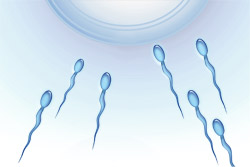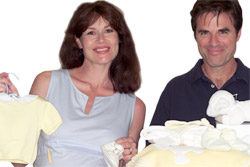What is fertilisation?
- What is in vitro fertilisation (IVF)?
- History of IVF
- Indications for IVF
- Who receives IVF treatment?
- How does IVF work?
- How is IVF performed?
- Effectiveness of IVF
- Factors affecting IVF outcomes
- How to prepare and what to expect during the IVF treatment cycle
- Benefits of IVF
- Limitations of and risks associated with IVF
- Psychological and ethical considerations relating to IVF
- Regulation of IVF in Australia
What is fertilisation?

The head of the sperm, (i.e. the part of the sperm contains the sperm’s chromosomes), will then penetrate the shell of the egg, called the zona pellucida and enter the nucleus of the egg (i.e. the section of the egg in which the egg’s chromosomes reside). The egg and sperm will combine their chromosomes. Each have 23 chromosomes (as opposed to normal cells which have 46 chromosomes), thus when their chromosomes are added together, they form a single normal cell, with 46 chromosomes. The joining of chromosomes from the sperm and oocyte represents the end of the fertilisation process.
The fertilised egg, known as an embryo, will then begin to grow and continue to travel through the fallopian tubes until it reaches the woman’s uterus. After 2-5 days the embryo will have grown to a size of eight cells, and the cells will begin to differentiate (i.e. take on different forms) into cells which will form the foetus, and those which will form the placenta. Five to six days after fertilisation the embryo will reach a size of 150-200 cells and have two distinct sections, an inner mass of cells which will become the foetus and an outer layer of cells which will form the placenta. At this stage the embryo becomes known as a blastocyst and is ready to implant in the walls of the uterus and form a pregnancy. If environmental conditions in the uterus are suitable and implantation occurs, the foetus will continue to develop and grow and a birth will occur some 39 weeks after fertilisation.
What is in vitro fertilisation (IVF)?
In vitro fertilisation (IVF) refers to the process of conceiving an embryo in a test tube. Embryos are conceived in vitro, when viable male sperm and female eggs are combined in a test tube or watch glass, in a substance with similar characteristics to the inside of a woman’s uterus. Once combined, the motile sperm will recognise eggs and bind to them and penetrate the zona pellucida (i.e. the ‘shell’) of the eggs, in the same manner that sperm bind to and fertilise eggs when they come into contact in a woman’s uterus, following intercourse.
In cases where infertility is underpinned by male factors (i.e. when motile sperm are not available), IVF can be performed using intracytoplasmic sperm injection (ICSI). ICSI involves injecting a single sperm into the centre of an ovum under a microscope. It therefore bypasses the process in which the sperm binds to and penetrates the egg’s zona pellucida. In doing so it enable sperm which are unable to bind to or penetrate the egg (i.e. sperm which do not have the ability to fertilise an egg) to be used for fertilisation.
IVF is an increasingly popular treatment for infertility in Australia. In 2003 more than 6000 babies were born as a result of IVF, compared to 2318 in 1994. There are a number of reasons for this. The average age at which Australian women give birth to their first child is increasing. A woman’s fertility declines with age, and declines dramatically after age 35. Infertility and the need for treatment therefore increases, as the average age of childbirth increases. Improved IVF techniques, which have lead to better outcomes (e.g. higher pregnancy rates), have also increased the popularity of IVF treatment.
History of IVF
The world’s first IVF pregnancy was reported in 1973 by a team of doctors researching at Monash University in Melbourne. This achievement followed years of exploratory research, using both human and animal embryos, through which techniques to fertilise human gametes (i.e. eggs and sperm) in vitro and later implant them into a woman’s uterus, were developed.
Unfortunately this first pregnancy lasted only a few days before spontaneous termination. Nonetheless, it represented a significant milestone in the development of IVF methods, as it demonstrated the potential for an embryo created in vitro to progress to the blastocyst stage and indicated the probability that such embryos could also implant and be carried to full gestational term.
Several years later (1976) a second IVF pregnancy, this time an ectopic pregnancy, was reported by British doctors. They later conceived the embryo which resulted in the world’s first live IVF birth, of baby Louise Brown, in England, 1978. A second British IVF baby was born later in 1978.
The first IVF baby in Australia (and the world’s third IVF baby) was born in 1980, under the supervision of the team of doctors at Monash University. Following this, the team at Monash established a further 14 pregnancies, resulting in nine live births before the end of 1981. IVF births were also achieved in the USA (1981) and France and Sweden (1982) in the early years of the 1980s.
The accessibility of IVF in Australia increased rapidly as did research into IVF and associated ART. IVF clinics were established in Sydney, Brisbane, Adelaide and Perth in the early 1980s. Australian scientists played (and continue to play) a leading role in the development of IVF technologies.
The key milestones in the development of IVF and associated ART techniques, many of which were the product of Australian research and practice, include:
- Development of reliable techniques to stimulate ovulation and predict oocyte maturation: were developed in 1981 by scientists at Monash University;
- Development of techniques to mature oocytes in vitro following retrieval: the Monash team were also responsible for the development of a technique which enabled retrieved oocytes to be further matured in the lab prior to insemination (1981-2). The additional maturation of oocytes improved the rate of fertilisation and remains common practice today;
- Effect of follicle stimulating hormone: in 1981 a US team of doctors recognised the effect of human follicle stimulating hormone in regulating ovulation and oocyte maturation, which lead to its use in ovulation stimulation;
- Advances in oocyte pick up: oocytes were first retrieved by French scientists via laparoscopy in 1968. Techniques to retrieve oocytes under local anaesthesia, using ultrasonic guidance were developed (also by French scientists) in 1983;
- Cryopreservation: preservation]: techniques to freeze for storage and later thaw embryos created in vitro were pioneered by the Monash team in the early 1980s and improved by French scientists in 1985. The world’s first live birth from frozen embryos occurred in Australia 1983;
- Techniques for the use of donor oocytes: the first IVF birth from donated oocytes, in a woman with no ovarian function, occurred in Australia in 1984;
- Intracytoplasmic sperm injection: an IVF technique involving the direct injection of sperm into the centre of an ovum, was established in 1992 by scientists from Belgium;
- Gamete Intra Fallopian Transfer (GIFT): the transfer of viable oocytes and sperm into the fallopian tubes for fertilisation was developed by a team of doctors in Sydney in 1993. While it was very popular in its early years, its use is now diminishing as the success of IVF techniques increases. It remains however, an important treatment option for individuals who may be morally opposed to the fertilisation of an oocyte in vitro (e.g. Roman Catholics who are prohibited by the Vatican to use any techniques which involve contact between and oocyte and sperm outside the woman’s body).
- Blastocyst implantation: Australia’s first baby grown in vitro to the blastocyst stage was born in 1997.
- Preimplantation genetic tests: as IVF techniques have enabled embryos to be created using poor quality eggs and sperm which would not otherwise be able to fertilise, the risk of conceiving a foetus with genetic abnormalities is higher in IVF compared to in vivo fertilisation. As a result, a range of tests which enable embryos to be screened for genetic abnormalities have been developed alongside other IVF techniques.
Indications for IVF

- Anovulatory infertility: couples with anovulatory infertility, who have achieved ovulation following pharmacological treatment (usually clomifene citrate [Infertility Treatment]) but failed to conceive after six months;
- Female tubal damage or obstruction: women whose fallopian tubes have been damaged (e.g. from prior surgery or infection)
- Male infertility: is now most commonly treated with ICSI, but conventional IVF is also used;
- Endometriosis: women with severe endometriosis may require IVF to conceive, however in mild cases ovarian stimulation is recommended before IVF is attempted;
- Failed donor insemination: when couples have tried but failed to conceive following six treatment cycles of intrauterine insemination using donor sperm, IVF using donor sperm is recommended.
In Australia, patients are eligible for a Medicare rebate once they have reached a threshold for out of pocket expenses in any calendar year. Some health insurance schemes cover infertility treatment, however the out of pocket expenses can be substantial.
Who receives IVF treatment?
The average age of women undergoing IVF in Australia was 35 years in 2003, increasing from 31 years in 1994. A significant proportion of women are over 40 years when they begin IVF treatment (25% in 2003, up from 13% in 1994).
How does IVF work?
IVF bypasses the fertilisation stage of conception and pregnancy, therefore it enables couples whose sperm and eggs are viable, but are unable to conceive within the woman’s body for one reason or another.
How is IVF performed?
IVF is a complex and usually lengthy process. It begins with a series of diagnostic tests, to assess the factors causing a couple’s infertility and determine whether or not IVF is an appropriate treatment strategy.
Once IVF is decided upon, mature oocytes must be retrieved from a woman’s ovaries (usually the woman who wishes to become pregnant, but in some cases a donor and sperm from a man’s testicles.
The eggs are first placed in a test tube, in a culture of saline and nutrients, and incubated. Sperm are added to the solution several hours later to enable the fertilisation process to occur and an embryo to form. In cases where male factors underpin infertility and no motile sperm are available, a technique known as intracytoplasmic sperm injection, in which sperm are injected directly into the centre of the oocyte, may be used.
Once fertilisation occurs, embryos are incubated in a culture medium which mimics conditions inside the uterus, for 2-5 days. The embryo begins to grow, and is considered ready for uterine implantation when it has grown to a size of eight cells. At this point the cells begin to differentiate in preparation to emerge from the zona pellucida. Cells are usually implanted into a woman’s uterus or cryopreserved for future use, about two days after fertilisation, when they are eight cells in size.
An embryo is transferred into the patient’s uterus, using a speculum to release the opening of the cervix. A catheter containing the embryo is then inserted through the cervical opening, enabling the embryo to be injected directly into the uterus. It is possible to transfer multiple embryos in one treatment cycle, however the transfer of more than two embryos per cycle is discouraged by Australian ethical guidelines. This is because the more embryos that are transferred, the more likely it is that a multiple pregnancy will occur (e.g. twins, triplets). Multiple pregnancies have a higher risk of pregnancy complications (e.g. miscarriage and low birth weight) and thus should be avoided.
Once the embryo is inserted it will then go on to grow in the same way that an embryo conceived naturally will grow to form a pregnancy. It will emerge from the zona pellucida, usually six days after fertilisation. At this stage, if the treatment is successful, the embryo should implant in the endometrial tissues of the uterus and form a pregnancy.
Effectiveness of IVF

Across all age groups the cumulative proportion who achieve pregnancy is 20.7% after one treatment cycle, around one half after three treatment cycles, and approximately two thirds after six treatment cycles. Only one in 200 couples continue with IVF after six treatment cycles.
The risk of complications (e.g. multiple pregnancies) has also decreased significantly, a result of a move towards implanting fewer embryos per cycles (e.g. in Australia guidelines recommend the implantation of 1-2 embryos, except in rare cases).
Factors affecting IVF outcomes
It is important to recognise however, that likelihood of pregnancy declines after each treatment cycle. There are a number of other factors affecting IVF outcomes, which are discussed further below.
The age of the woman being treated is the strongest predictor of whether or not IVF will result in live birth. The chance of successful IVF reduces as a woman ages. In Australia in 2003, there was a 27.7% rate of live birth per IVF treatment cycle commenced amongst women 20-29 years. The proportion of treatment cycles resulting in live birth declined to 24.9% in the 30-34 years age group, 17.1% in the 35-39 year age group and 6.8% in the 40-44 year age group.
The more embryos transferred into the uterus of a woman trying to conceive, the greater the chance of live birth. However, the transfer of multiple embryos also increases the risk of multiple pregnancies (which carries an increased risk for both the pregnant woman and the foetuses). In Australia 95.6% of all IVF procedures involve the implantation of 1-2 embryos per cycle, and the transfer of more than two embryos per treatment cycle is discouraged, to reduce the risk of multiple births.
Number of previous treatment cycles
The chance of live birth is constant in the first three cycles of IVF treatment, however it declines thereafter.
The origin of the oocyte (i.e. whether the female gametes which will be implanted come from donors or the woman who will carry the child), influences the likelihood of IVF success. Success is more likely if an embryo is created from the oocytes of the woman into which it will be implanted.
Treatment has a better chance of success if fresh rather than frozen gametes or embryos are used.
IVF is more likely to succeed in women who have previously had a live birth than in women who have not.
Consumption of even small quantities of alcohol (e.g. one standard drink per day) by men or women undergoing IVF reduces the likelihood of successful outcome.
Maternal and paternal smoking reduces the likelihood of ART treatment success.
Use of recreational drugs (e.g. marijuana and cocaine) and some over the counter drugs (e.g. steroids) reduces a couple’s fertility. While no trials have specifically examined the impact of drug use on IVF outcome, it is likely that drug use also reduces the success of IVF.
How to prepare and what to expect during IVF treatment cycle

Before beginning a treatment cycle, it is important for women to have a pap smear (or to have had a pap smear within 2 years), to ensure they are free of cervical cancer. They should also check their Rubella (i.e German Measles) immunity, even if they have been immunised in the past. Both men and women should be checked for syphilis, an often asymptomatic STI, which can seriously affect a developing foetus. Men should have had a semen analysis test within the last twelve months. ( preconception advice)
Many couples will wish to undergo counselling before a treatment cycle begins, and in some states and territories, counselling is mandatory before commencing IVF treatment. Regardless of legislation, counselling highly recommended as it is a good opportunity for them to find out more about IVF treatment and what to expect, as well as to express their fears and concerns.
Couples wishing to undergo IVF should obtain a referral for specialist treatment from their general practitioner, in order to claim a Medicare rebate. Couples will also meet, on one or more occasions, nurses and/or gynaecologists, before their IVF treatment cycles begin. At these meetings, tests will be performed to determine the most appropriate pharmacological regimen to induce ovulation.
The IVF treatment cycle will be discussed and the couple will be taught how to administer the pharmaceuticals which the female partner will take during the treatment cycle to induce ovulation. This usually includes some injections. Medications will be prescribed and the couple will take them home, so that they are ready to commence treatment at the appropriate time and do not have to make daily visits to the clinic.
A treatment cycle begins on the first day of a woman’s period. The woman being treated will commence taking medication some point after her period begins, however the day on which medication commences differs according to medication type. All women will be asked to contact their IVF clinic on the first day of their period, so that the day they should start taking medications can be calculated. Ultrasonic investigation will be performed some time after medication has commenced, to assess the extent of ovarian follicle growth (i.e. the number and size of follicles) and the thickness of the endometrial lining. The ultrasound will provide the information needed to calculate the correct time to administer medications to stimulate the release of oocytes from ovarian follicles to prepare for oocyte retrieval.
The woman being treated will be asked to attend the IVF clinic about 36 hours after HCG is administered, so that oocytes can be removed from her ovaries.The woman’s partner will also be requested to attend the clinic on that day to produce a sperm sample, which will be used for IVF of the retrieved oocytes. Once removed, oocytes are generally allowed to mature for several hours in a culture medium, prior to insemination. Once combined, the gametes will be incubated and monitored to check if fertilisation occurs, in which case the resulting embryos will be allowed to grow in vitro for 2-5 days. The IVF clinic will monitor the fertilisation progress and contact patients to advise them when to return so that the embryos can be transferred into the woman’s uterus.
Embryo transfer is a simple procedure through which the embryos are injected directly into the uterus using a catheter, under ultrasound guidance. It takes only a few minutes and patients undergoing embryo transfer do not need to take any medications to prepare for the procedure, or undergo anaesthetic. In many clinics, patients can view the entire process via the ultrasound monitor and partners are able to watch.
After the embryo/s have been implanted, the patient can immediately resume normal activities. A blood pregnancy test is performed 18 days after embryo transfer to confirm whether or not a pregnancy has formed. Most couples find this an anxious and stressful waiting period, and couples must be prepared to receive a negative result. If a period occurs within 18 days of embryo transfer, this usually means the embryo has not implanted and another treatment cycle will be necessary. However it is very important for all women, including those who experience a period following embryo transfer, to return to their IVF clinic for a pregnancy test, as vaginal bleeding may indicate a more serious condition requiring treatment.
Benefits of IVF

Limitations of and risks associated with IVF
IVF is dependent on the availability of viable human sperm and eggs for fertilisation. It is not a treatment which can repair damaged eggs or increase the viability of sperm produced. As an individual’s eggs or sperm deteriorate in quality as they age, the success of IVF is more limited amongst older couples.
There are a number of long and short term risks associated with the IVF process. In the short term, hyperovarian stimulation syndrome is a potentially serious condition associated with ovarian stimulation.
There is also an increased risk of multiple pregnancies, which threaten the health of both the pregnant woman and the foetuses (e.g. more physical strain on the pregnant woman and a higher risk of miscarriage). In 2003 more than 18% of IVF pregnancies in Australia and New Zealand resulted in multiple births, compared to 1.7% of pregnancies achieved through natural conception. The average birth weight of babies conceived through IVF is lower than babies resulting from natural conception (3010 grams compared to 3372 grams respectively) and there is a higher rate of perinatal and neonatal deaths amongst IVF conceived babies.
In the long term, further research is needed to determine whether or not babies born through IVF have a higher risk of congenital abnormalities and growth disorders, compared to babies resulting from natural conception.
Psychological and ethical considerations relating to IVF
IVF treatment can often be a lengthy, costly and emotionally draining process for both the woman undergoing treatment and her partner. It is common for both partners to experience anxiety and depression during the treatment and experience stress while awaiting their treatment outcome. IVF parents also experience more stress during pregnancy than couples who conceive naturally, stress that can negatively affect the outcome of the pregnancy. If the result of IVF is unsuccessful, feelings of sadness, anger and depression are common.
Regulation of IVF in Australia
In the early days of IVF, legislation to regulate the clinical practice of IVF did not exist. Now, IVF and other ART practitioners are licensed by the Infertility Society of Australia and the National Health and Medical Research Council provides ethical guidelines for IVF research and practice.
The Human Cloning and Human Embryos Act regulates ART research at a national level, however there is no national legislation regulating ART in clinical practice. Rather, these practices are legislated on a state by state basis. There are considerable differences between states in terms of when they first legislated ART, and how it is regulated, which are discussed further below.
Victoria was the first state in Australia and the first government in the world to regulate the practice of IVF, through the introduction of the Infertility (Medical Procedures) Act 1984. The Bill was first bought before Parliament in 1984, however was not adopted in its entirety until 1987, when it was adopted alongside the Infertility (Medical Procedures) Amendment Act 1987. These bills were later superseded by the introduction of the Infertility Treatment Act 1995. This act increased the number of ART procedures regulated and established the Infertility Treatment Authority to monitor and provide licences to clinics, doctors and scientists participating in IVF techniques. It also stipulated that embryos can be stored for a maximum of five years and sperm a maximum of ten years.
New South Wales is the only Australian state that has not introduced legislation to regulate the practice of IVF and associate ART techniques. It operates in accordance with the National Health and Medical Council’s ethical guidelines for the ART.
Queensland introduced the Surrogate Parenthood Act 1988 to regulate ART resulting in gestational surrogacy, however for the most part ART is regulated in accordance with the NHMRC guidelines.
Clinical practice of IVF is regulated by the Reproductive Technology (Clinical Practice) Act in South Australia.
Western Australia regulates ART procedures through the Human Reproductive Technology Act and amendments to this act.
In the Australian Capital Territory, ART is regulated under the RTAC Code of Practice, produced by the Fertility Society of Australia. Surrogacy is regulated through the Substitute Parent Agreements Act (1994) and Artificial Conception Act (1985).
Tasmania regulates ART in accordance with NHMRC guidelines, however has separate legislation, the Surrogacy Contracts Act (1993) to regulate gestational surrogacy arrangements.
The Northern Territory uses South Australian legislation as a guide for regulating ART.
More information
 |
For more information on infertility, including investigations and treatments, as well as some useful animations, see Infertility. |
 |
For more information on alternative treatments, see Infertility Treatments / Assisted Reproductive Technologies (ARTs). |
References
- Waters AM, Dean JH, Sullivan EA. Assisted reproduction technology in Australia and New Zealand 2003 [online]. Australian Institute for Health and Welfare, National Perinatal Statistics Unit. February 2006 [cited 10 December 2008]. Available from URL: http://www.npsu.unsw.edu.au/PRERUWeb.nsf/page/art9high
- Gianaroli L, Plachot M, van Kooij R, Al-Hasani S, Dawson K, DeVos A, et al. ESHRE guidelines for good practice in IVF laboratories. Hum Reprod. 2000;15(10):2241-6.
- Hirsch A. Male subfertility. BMJ. 2003;327(7416):669-72.
- De Kretzer D, Dennis P, Hudson B, Leeton J, Lopata A, Outch K, et al. Transfer of a human zygote. Lancet. 1973;2(7831):728-9.
- Cohen J, Trounson A, Dawson K, Jones H, Hazekamp J, Nygren KG, et al. The early days of IVF outside the UK. Hum Reprod Update. 2005;11(5):439-59.
- Edwards RG, Steptoe PC, Purdy JM. Establishing full-term human pregnancies using cleaving embryos grown in vitro. Br J Obstet Gynaecol. 1980;87(9):737-56.
- Lopata A, Johnston IW, Hoult IJ, Speirs AI. Pregnancy following intrauterine implantation of an embryo obtained by in vitro fertilization of a preovulatory egg. Fertil Steril. 1980;33(2):117-20.
- Trounson AO, Leeton JF, Wood C, Webb J, Wood J. Pregnancies in humans by fertilization in vitro and embryo transfer in the controlled ovulatory cycle. Science. 1981;212(4495):681-2.
- Testart J, Frydman R, Feinstein MC, Thebault A, Roger M, Scholler R. Interpretation of plasma luteinizing hormone assay for the collection of mature oocytes from women: definition of a luteinizing hormone surge-initiating rise. Fertil Steril. 1981;36(1):50-4.
- Testart J, Lassalle B, Belaisch-Allart J, Hazout A, Forman R, Rainhorn JD, et al. High pregnancy rate after early human embryo freezing. Fertil Steril. 1986;46(2):268-72.
- Trounson A, Mohr L. Human pregnancy following cryopreservation, thawing and transfer of an eight-cell embryo. Nature. 1983;305(5936):707-9.
- Lutjen P, Trounson A, Leeton J, Findlay J, Wood C, Renou P. The establishment and maintenance of pregnancy using in vitro fertilization and embryo donation in a patient with primary ovarian failure. Nature. 1984;307(5947):174-5.
- Palermo G, Joris H, Devroey P, Van Steirteghem AC. Pregnancies after intracytoplasmic injection of single spermatozoon into an oocyte. Lancet. 1992;340(8810):17-8.
- Key milestones at Monash IVF [online]. Monash IVF. November 2006 [cited 10 December 2008]. Available from URL: http://www.monashivf.com/default.asp?action=article&ID=21851
- National Collaborating Centre for Women’s and Children’s Health. Clinical guideline: Fertility: Assessment and treatment for people with fertility problems [online]. Royal College of Obstetricians and Gynaecologists. 1 February 2004 [cited 30 December 2008]. Available from URL: http://www.rcog.org.uk/womens-health/clinical-guidance/fertility-assessment-and-treatment-people-fertility-problems
- Balen AH, Rutherford AJ. Management of infertility. BMJ. 2007;335(7620):608-11.
- Laws PJ, Sullivan EA. Australia’s mothers and babies 2003 [online]. Sydney: Australian Institute of Health and Welfare, National Perinatal Statistics Unit. 9 December 2005 [cited 30 December 2008]. Available from URL: http://www.aihw.gov.au/publications/index.cfm/title/10202
- Malter HE, Cohen J. Intracytoplasmic sperm injection: Technical aspects. In: Vayena E, Rowe PJ, Griffin PD (eds). Current Practices and Controversies in Assisted Reproduction [online]. Geneva: World Health Organisation; 2002 [cited 30 December 2008]. pp. 126-33. Available from URL: http://whqlibdoc.who.int/hq/2002/9241590300.pdf
- Hartshorne G. Current scientific developments in assisted conception: Oocyte maturation in vitro. In: Brinsden PR (ed). Textbook of In Vitro Fertilization and Assisted Reproduction: The Bourn Hall Guide to Clinical and Laboratory Practice (2nd edition). New York: Parthenon Publishing Group; 1999. pp 292-3.
- National Health and Medical Council of Australia. Ethical guidelines on the use of assisted reproductive technology in clinical practice and research [online]. Australian Government National Health and Medical Council. June 2007 [cited 30 December 2008]. Available from URL: http://www.nhmrc.gov.au/publications/synopses/e78syn.htm
- Kovacs G. "The history of IVF: 35 years of human-assisted reproduction from 1973 to 2008. O&G Magazine. 2007;9(4):10-11.
- Kovacs GT, Maclachlan V, Brehny S. What is the probability of conception for couples entering an IVF program? Aust N Z J Obstet Gynaecol. 2001;41(2):207-9.
- Devroey P, Bourgain C, Macklon NS, Fauser BC. Reproductive biology and IVF: Ovarian stimulation and endometrial receptivity. Trends Endocrinol Metab. 2004;15(2):84-90.
- Kojima K, Nomiyama M, Kumamoto T, Matsumoto Y, Iwasaka T. Transvaginal ultrasound-guided embryo transfer improves pregnancy and implantation rates after IVF. Hum Reprod. 2001;16(12):2578-82.
- Eugster A, Vingerhoets AJ. Psychological aspects of in vitro fertilization: A review. Soc Sci Med. 1999;48(5):575-89.
- Reproductive technology: Legislation around Australia [online]. Government of South Australia Department of Health. 5 September 2007 [cited 30 December 2008]. Available from URL: http://www.dh.sa.gov.au/reproductive-technology/other.asp
- Meldrum DR, Silverberg KM, Bustillo M, Stokes L. Success rate with repeated cycles of in vitro fertilization-embryo transfer. Fertil Steril. 1998;69(6):1005-9.
All content and media on the HealthEngine Blog is created and published online for informational purposes only. It is not intended to be a substitute for professional medical advice and should not be relied on as health or personal advice. Always seek the guidance of your doctor or other qualified health professional with any questions you may have regarding your health or a medical condition. Never disregard the advice of a medical professional, or delay in seeking it because of something you have read on this Website. If you think you may have a medical emergency, call your doctor, go to the nearest hospital emergency department, or call the emergency services immediately.








